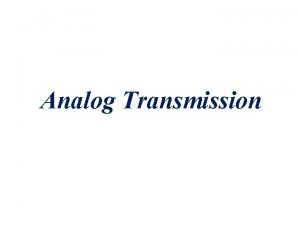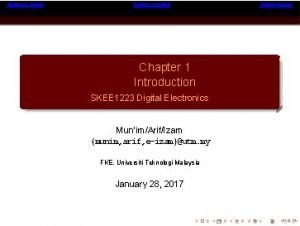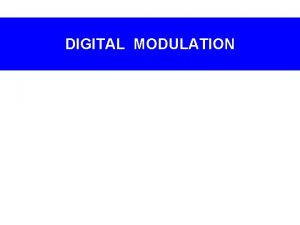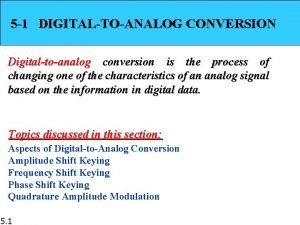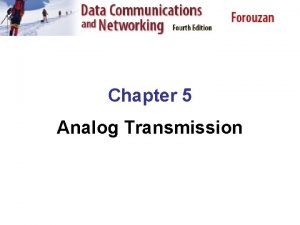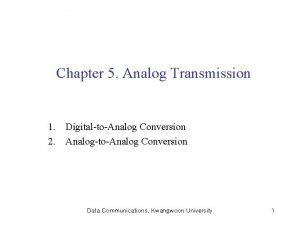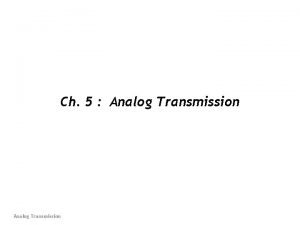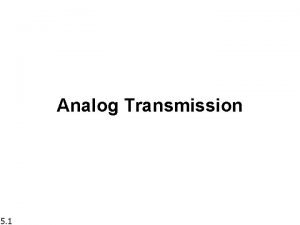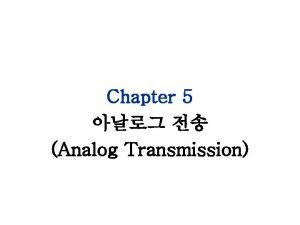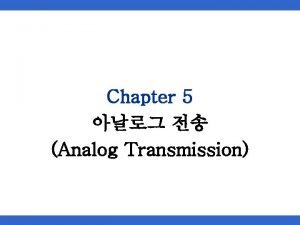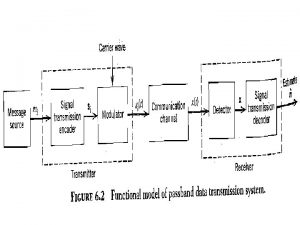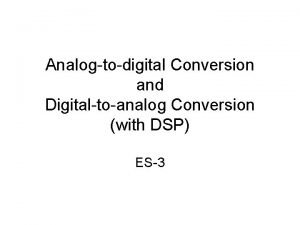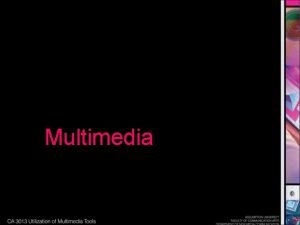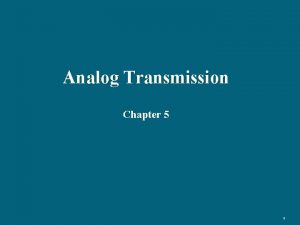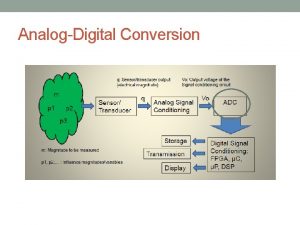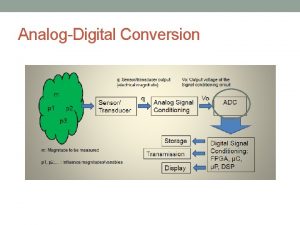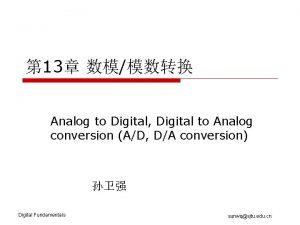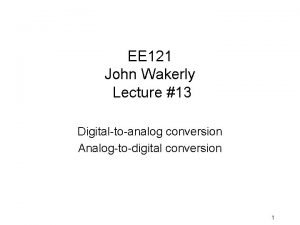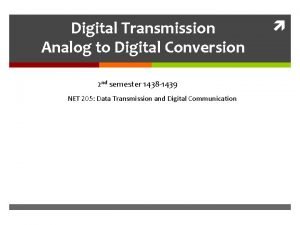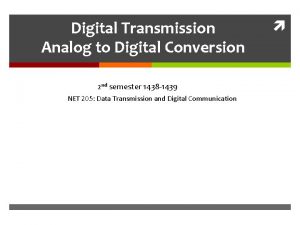Chapter 5 Analog Transmission Digitaltoanalog conversion is the




























- Slides: 28

Chapter 5 Analog Transmission Digital-to-analog conversion is the process of changing one of the characteristics of an analog signal based on the information in digital data. Figure 5. 1 Digital-to-analog conversion

Chapter 4 n Digital Transmission Data Encoding refers the various techniques of impressing data (0, 1) or information on an electrical, electromagnetic or optical signal that would propagate through the physical medium making up the communication link between the two devices.

5 -1 DIGITAL-TO-ANALOG CONVERSION Topics discussed in this section: Aspects of Digital-to-Analog Conversion Amplitude Shift Keying Frequency Shift Keying Phase Shift Keying Quadrature Amplitude Modulation

• Bit rate is the number of bits per second. Baud rate is the number of signal elements per second. • In the analog transmission of digital data, the baud rate is less than or equal to the bit rate. Example 5. 1 An analog signal carries 4 bits per signal element. If 1000 signal elements are sent per second, find the bit rate. Solution In this case, r = 4, S = 1000, and N is unknown. We can find the value of N from

Example 5. 2 An analog signal has a bit rate of 8000 bps and a baud rate of 1000 baud. How many data elements are carried by each signal element? How many signal elements do we need? Solution In this example, S = 1000, N = 8000, and r and L are unknown. We find first the value of r and then the value of L.

Figure 5. 3 Binary amplitude shift keying Figure 5. 4 Implementation of binary ASK

Example 5. 3 We have an available bandwidth of 100 k. Hz which spans from 200 to 300 k. Hz. What are the carrier frequency and the bit rate if we modulated our data by using ASK with d = 1? Solution The middle of the bandwidth is located at 250 k. Hz. This means that our carrier frequency can be at fc = 250 k. Hz. We can use the formula for bandwidth to find the bit rate (with d = 1 and r = 1).

Example 5. 4 In data communications, we normally use full-duplex links with communication in both directions. We need to divide the bandwidth into two with two carrier frequencies, as shown in Figure 5. 5. The figure shows the positions of two carrier frequencies and the bandwidths. The available bandwidth for each direction is now 50 k. Hz, which leaves us with a data rate of 25 kbps in each direction.

Figure 5. 6 Binary frequency shift keying

Example 5. 5 We have an available bandwidth of 100 k. Hz which spans from 200 to 300 k. Hz. What should be the carrier frequency and the bit rate if we modulated our data by using FSK with d = 1? Solution This problem is similar to Example 5. 3, but we are modulating by using FSK. The midpoint of the band is at 250 k. Hz. We choose 2Δf to be 50 k. Hz; this means

Figure 5. 7 Bandwidth of MFSK used in Example 5. 6

Example 5. 6 We need to send data 3 bits at a time at a bit rate of 3 Mbps. The carrier frequency is 10 MHz. Calculate the number of levels (different frequencies), the baud rate, and the bandwidth. Solution We can have L = 23 = 8. The baud rate is S = 3 MHz/3 = 1000 Mbaud. This means that the carrier frequencies must be 1 MHz apart (2Δf = 1 MHz). The bandwidth is B = 8 × 1000 = 8000. Figure 5. 8 shows the allocation of frequencies and bandwidth.

Figure 5. 9 Binary phase shift keying Figure 5. 10 Implementation of BASK

Figure 5. 11 QPSK and its implementation

Example 5. 7 Find the bandwidth for a signal transmitting at 12 Mbps for QPSK. The value of d = 0. Solution For QPSK, 2 bits is carried by one signal element. This means that r = 2. So the signal rate (baud rate) is S = N × (1/r) = 6 Mbaud. With a value of d = 0, we have B = S = 6 MHz. Figure 5. 12 Concept of a constellation diagram

Example 5. 8 Show the constellation diagrams for an ASK (OOK), BPSK, and QPSK signals. Solution Figure 5. 13 shows the three constellation diagrams.

Quadrature amplitude modulation is acombination of ASK and PSK. Figure 5. 14 Constellation diagrams for some QAMs

Time domain for an 8 -QAM signal

A constellation diagram consists of eight equally spaced points on a circle. If the bit rate is 4800 bps, what is the baud rate? Solution The constellation indicates 8 -PSK with the points 45 degrees apart. Since 23 = 8, 3 bits are transmitted with each signal unit. Therefore, the baud rate is 4800 / 3 = 1600 baud Example 10 Example 11 Compute the bit rate for a 1000 -baud 16 -QAM signal. Solution A 16 -QAM signal has 4 bits per signal unit since log 216 = 4. Thus, (1000)(4) = 4000 bps Example 12 Solution Compute the baud rate for a 72, 000 -bps 64 -QAM signal. A 64 -QAM signal has 6 bits per signal unit since log 2 64 = 6. Thus, 72000 / 6 = 12, 000 baud

5. 2 Telephone Modems Modem Standards Modem stands for modulator/demodulator.

Figure 5. 18 Telephone line bandwidth A telephone line has a bandwidth of almost 2400 Hz for data transmission.

Figure 5. 20 Figure 5. 21 The V. 32 constellation and bandwidth The V. 32 bis constellation and bandwidth

Figure 5. 22 Traditional modems

Figure 5. 23 56 K modems

5 -2 ANALOG AND DIGITAL Analog-to-analog conversion is the representation of analog information by an analog signal. One may ask why we need to modulate an analog signal; it is already analog. Modulation is needed if the medium is bandpass in nature or if only a bandpass channel is available to us. Figure 5. 15 Types of analog-to-analog modulation

Figure 5. 16 Amplitude modulation The total bandwidth required for AM can be determined from the bandwidth of the audio signal: BAM = 2 B. Figure 5. 17 AM band allocation

Figure 5. 18 Frequency modulation The total bandwidth required for FM can be determined from the bandwidth of the audio signal: BFM = 2(1 + β)B. Figure 5. 19 FM band allocation

Figure 5. 20 Phase modulation The total bandwidth required for PM can be determined from the bandwidth and maximum amplitude of the modulating signal: BPM = 2(1 + β)B.
 Digital vs analog transmission
Digital vs analog transmission Digital to analog conversion in data communication
Digital to analog conversion in data communication Vhmax
Vhmax Puncture resistant container
Puncture resistant container Chapter 19 disease transmission and infection prevention
Chapter 19 disease transmission and infection prevention Chapter 15:9 maintaining transmission based precautions
Chapter 15:9 maintaining transmission based precautions Chapter 19 disease transmission and infection prevention
Chapter 19 disease transmission and infection prevention Hình ảnh bộ gõ cơ thể búng tay
Hình ảnh bộ gõ cơ thể búng tay Lp html
Lp html Bổ thể
Bổ thể Tỉ lệ cơ thể trẻ em
Tỉ lệ cơ thể trẻ em Chó sói
Chó sói Chụp tư thế worms-breton
Chụp tư thế worms-breton Alleluia hat len nguoi oi
Alleluia hat len nguoi oi Các môn thể thao bắt đầu bằng tiếng chạy
Các môn thể thao bắt đầu bằng tiếng chạy Thế nào là hệ số cao nhất
Thế nào là hệ số cao nhất Các châu lục và đại dương trên thế giới
Các châu lục và đại dương trên thế giới Công thức tiính động năng
Công thức tiính động năng Trời xanh đây là của chúng ta thể thơ
Trời xanh đây là của chúng ta thể thơ Mật thư tọa độ 5x5
Mật thư tọa độ 5x5 Phép trừ bù
Phép trừ bù Phản ứng thế ankan
Phản ứng thế ankan Các châu lục và đại dương trên thế giới
Các châu lục và đại dương trên thế giới Thơ thất ngôn tứ tuyệt đường luật
Thơ thất ngôn tứ tuyệt đường luật Quá trình desamine hóa có thể tạo ra
Quá trình desamine hóa có thể tạo ra Một số thể thơ truyền thống
Một số thể thơ truyền thống Bàn tay mà dây bẩn
Bàn tay mà dây bẩn Vẽ hình chiếu vuông góc của vật thể sau
Vẽ hình chiếu vuông góc của vật thể sau Nguyên nhân của sự mỏi cơ sinh 8
Nguyên nhân của sự mỏi cơ sinh 8

